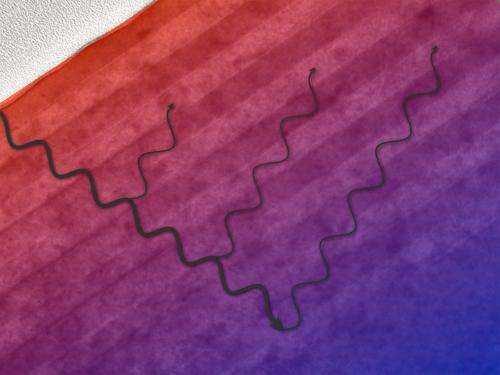Controlling heat flow through a nanostructure

MIT researchers find that heat moving in materials called superlattices behaves like waves; finding could enable better thermoelectrics.
Thermoelectric devices, which can harness temperature differences to produce electricity, might be made more efficient thanks to new research on heat propagation through structures called superlattices. The new findings show, unexpectedly, that heat can travel like waves, rather than particles, through these nanostructures: materials made up of layers only a few billionths of a meter in thickness.
Heat—the vibration of atoms and molecules in a material—usually travels in a "random walk," which is difficult to control. The new observations show a very different pattern, called coherent flow, which is more like ripples that move across a pond in an orderly way.
This opens the possibility of new materials in which the flow of heat could be precisely tailored—materials that could have important applications. For example, such research might lead to new ways of shedding the heat generated by electronic devices and semiconductor lasers, which hampers performance and can even destroy the devices.
The new work, by graduate student Maria Luckyanova, postdoc Jivtesh Garg and professor Gang Chen, all of MIT's Department of Mechanical Engineering—along with other students and professors at MIT, Boston University, the California Institute of Technology and Boston College—is reported this week in the journal Science.
The study involves a nanostructured material called a superlattice: in this case, a stack of alternating thin layers of gallium arsenide and aluminum arsenide, each deposited in turn through a process called metal-organic chemical vapor deposition. Chemicals containing these elements are vaporized in a vacuum, and then deposited on a surface, their thicknesses precisely controlled through the duration of the deposition process. The resulting layers were just 12 nanometers thick—about the thickness of a DNA molecule—and the entire structures ranged in thickness from 24 to 216 nanometers.
Researchers had previously believed that even though such layers could be atomically perfect, there would still be enough roughness at the interfaces between the layers to scatter heat-transporting quasi-particles, called phonons, as they moved through the superlattice. In a material with many layers, such scattering effects would accumulate, it was thought, and "destroy the wave effect" of the phonons, says Chen, the Carl Richard Soderberg Professor of Power Engineering. But this assumption had never been proved, so he and his colleagues decided to re-examine the process, he says.
Indeed, experiments by Luckyanova and computer simulations by Garg showed that while such phase-randomizing scattering takes place among high-frequency phonons, wave effects were preserved among low-frequency phonons. Chen says he was very surprised when Luckyanova came back with the first experimental data to show "that coherent conduction of heat is really happening."
Understanding the factors that control this coherence could, in turn, lead to better ways of breaking that coherence and reducing the conduction of heat, Chen says. This would be desirable in thermoelectric devices to harness unused heat energy in everything from powerplants to electronics. Such applications require materials that conduct electricity very well but conduct heat very poorly.
The work could also improve the shedding of heat, such as for the cooling of computer chips. The ability to focus and direct heat flow could lead to better thermal management for such devices. Chen says researchers don't yet know how to exert such precise control, but the new understanding could help. Understanding this wave-based mechanism "gives you more ways to manipulate the transport" of heat, he says.
The two materials used in this experiment have very similar properties, Luckyanova says, and conduct electricity very well. But by controlling the thickness and spacing of the layers, she says, "we believe we can manipulate the thermal transport," producing the kind of insulating effect needed for thermoelectric devices.
The role of interfaces between the layers of a material "is something that was not really understood," Garg says. Previous simulations had failed to include the effects of variation in surface texture on the process, he says, but "I realized there was a way to simulate the role of roughness" on the way phonons moved through the stack of layers.
The new work not only provides the possibility of controlling the flow of heat (mostly carried by phonons with short wavelengths) but also for controlling the movement of sound waves (primarily carried by longer-wavelength phonons). "It's really a sort of fundamental understanding," Chen says.
The insights that made the work possible arose in large part through interactions between researchers in different disciplines, facilitated through the Solid State Solar-Thermal Energy Conversion Center, an Energy Frontier Center funded by the U.S. Department of Energy, which holds regular cross-disciplinary meetings at MIT. "Those meetings provided long, fruitful discussions that really strengthened the paper," Luckyanova says. The variety of people in the group "really encouraged us to attack this problem from all sides."
Journal information: Science
Provided by Massachusetts Institute of Technology




















